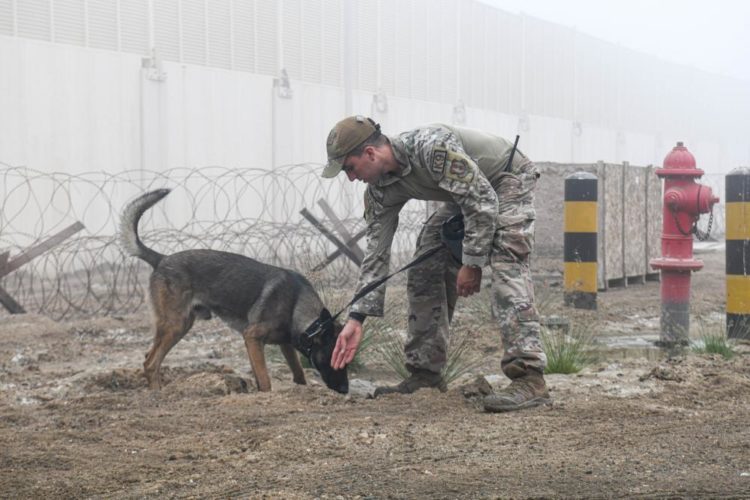The 380th Expeditionary Security Forces Squadron continues to “Hold the Line” at Al Dhafra Air Force Base, United Arab Emirates. In order to achieve that, consistent training, vigilance and teamwork are required to ensure nothing slips by undetected. Although the Defenders of ADAB are trained, equipped and ready to handle whatever threats may come their way, it doesn’t hurt to have a little help from a friend — especially one that walks on four legs.
The handful of Military Working Dogs and their handlers assigned to the 380th ESFS work together to secure the base by working patrols. With a primary interest in explosive detection, MWDs are used to search buildings, vehicles, gates, perimeter fences and more. Additionally, MWDs are capable of chasing down and apprehending suspects on command.
It’s the job of the handler to read an MWD’s change in behavior. Just as people will change their behavior in certain environments or to certain stimuli, trained MWDs associate the smell of specific odors with getting rewarded and anticipate that reward. Handlers have to be on the lookout for those tells.
“Dogs smell differently than humans.” said Staff Sgt. Mckenzie Langan, an MWD handler assigned to the 380th ESFS. “You might smell a cheeseburger, but the dog will smell the meat, the ketchup, cheese, bun — each individual smell. So they are able to distinguish between that one odor they are supposed to find and everything else.”
Although many dogs have the ability to separate different scents, it take months of training before they are utilized as MWDs.
“Our dogs are either born in San Antonio at Lackland, or the Air Force purchases them over from Europe,” said Langan. “Belgian Malinois, German Shepherds and Labradors are the main three breeds the military uses, but there are other breeds as well. The Navy also has little dogs for their ships.”
Once selected for the program, the canines begin their training at the 341st Training Squadron at Lackland AFB, Texas. Once there, training can take as little as two months to as long as six months, depending on how well a dog’s abilities improve. Prior to being released out for service, MWDs are validated and certified by lead training officials.
“Most dogs are ready to work after they are two years old,” said Tech. Sgt. Latif Self, the kennel master assigned to the 380th ESFS. “But it depends; our one dog Bak is two now, so he got an early start. It all depends on how mature they are and how quickly their abilities improve.”
With their initial training complete, MWDs are assigned to a Security Forces Squadron and are matched with a handler from that squadron. Although MWDs are deemed operational, the training never stops and it’s the job of the handler to tune in to the personality of the dog, and continue developing its skills. For Langan, reading books on new training techniques keeps her on top of her game.
“A really good book is, ‘Don’t Shoot the Dog’, It explains positive reinforcement really, really well,” said Langan. “The main thing is keeping dogs accountable 24/7. It feels like an impossible task but you have to try do it. You have to continue training past the training sessions. If I’m only giving corrections or rewards in the obedience yard but not outside of it, that’s when a dog becomes more stubborn. Positive reinforcement is a good way to teach rather than punish. It’s a really useful way to shape their behaviors.”
Langan has been working with her MWD, Adja, for approximately two years.
Already have an account? Sign In
Two ways to continue to read this article.
Subscribe
$1.99
every 4 weeks
- Unlimited access to all articles
- Support independent journalism
- Ad-free reading experience
Subscribe Now
Recurring Monthly. Cancel Anytime.









